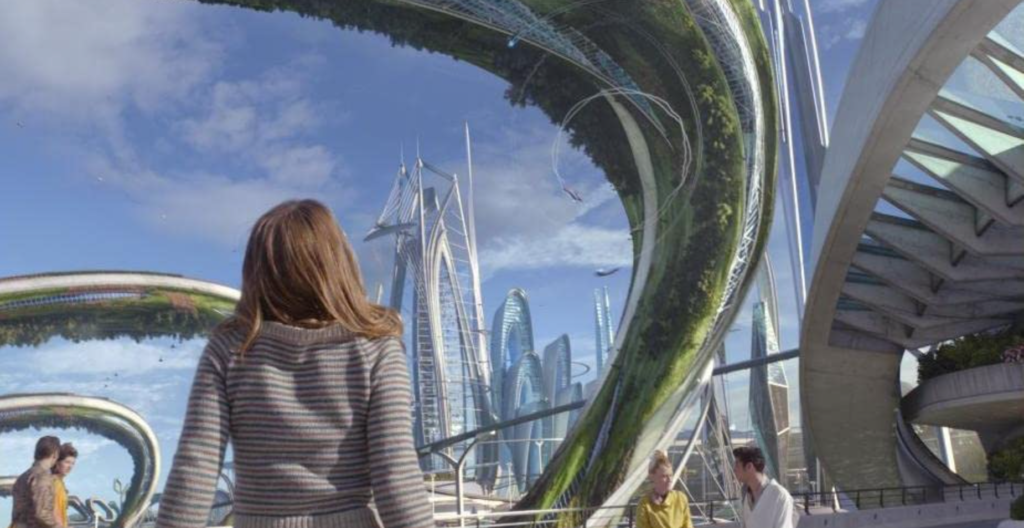How we lost the future

When was the last time you saw a genuinely new vision of the future — one that didn’t simply rehash notions that have been around since long before you were born? They are remarkably hard to find these days. Take a close look at the props that clutter up images of the future in popular culture, and you’ll find that most of them are antiques.
Flying cars are a great example. They’re anything but new; US aviation pioneer Glenn Curtiss built and tested the first flying car in 1917. There have been many others since then, and some of them worked, after a fashion. The problem is that the engineering compromises needed to make a vehicle that’s both roadworthy and airworthy guarantee that your flying car will have lousy performance in either role. It will also cost so much that for the same price, you could buy a good car, a good plane, and put a down payment on a midsized yacht. That’s why we don’t have flying cars. They’ve been tried, they’ve failed, and only the fact that people won’t let go of the fantasy keeps engineers perpetually pushing on a door marked “Pull”.
Take any other iconic technogimmick that popular culture assigns to the future and you’ll find that it was a familiar notion a century ago. Fusion power? Jules Verne wrote about that in 1869. Replacement of human labour by robots? Introduced in 1921 by Karel Capek, the writer who invented the word “robot”. 24/7 internet connectivity for all? It’s a major plot point in E.M. Forster’s 1909 tale The Machine Stops. Space travel? Already done to death before the pulp magazines of the Twenties got to it. All of them, interestingly enough, turned out to have the same problem that doomed the flying car: sure, they’re possible — well, except for fusion power; the jury’s still out on whether that can be done on a scale smaller than a star — but the limited benefits don’t begin to cover the sky-high costs.
Yet the same old futures, grey with decades of dust, remain stuck in place in the popular imagination. Take Star Trek, the show that still defines the future for an embarrassingly large number of people. It premiered in 1966. In that year cars still had tailfins, surfer movies starring Annette Funicello and Frankie Avalon were all the rage, books on space travel had chapters beginning “When man lands on the Moon,” and slide rules were the standard calculating device because computers were fragile contraptions the size of warehouses. That was the year when Ronald Reagan began his political career. Star Trek isn’t our future. It’s the embalmed corpse of a future that fell over dead a long time ago.
There’s an ugly political subtext behind this act of mummification. The rebels of the 1960s and 1970s framed their challenges to the status quo in visionary terms, portraying futures dramatically different from the present. Theodore Roszak’s Where the Wasteland Ends (1972) and Ernest Callenbach’s Ecotopia (1978) were among the most widely read of the literature that resulted. Those challenges caused stark panic among the comfortable classes. When the backlash hit in the 1980s, the corporate establishment set out to erase the idea that the future could differ from the present in any way that mattered.
Those who lived through those years will recall how environmental action groups were bought out and neutered, the scruffy radicals who founded them abruptly replaced by slick corporate enablers. The same thing happened to every other movement that threatened the existing order of things: that’s when feminism gave up on changing society, for example, and settled instead for giving middle-class women prestige jobs within the system. Stuffing the visionary futures of the previous decades down the nearest available memory hole was part of the same process.
That’s how we spent forty years spent parading around the crumbling mummy of a failed future under the delusion that we were doing something innovative. At this point even true believers are beginning to have doubts. Every year we get told by the lab-coated cheerleaders of progress as usual that fusion power is only twenty more years in the future, that we’ll be going back to the Moon sometime soon, and so on through a litany of broken promises. Meanwhile creeping dysfunction spreads through the world’s industrial nations, marked by the accelerating decay of the built environment and the ongoing crapification of everyday life.
The result has been a paralysis of the imagination with dismal political consequences. Have you noticed how many of the political crusades of the last forty years have been against something rather than for something? It’s all about fighting this or stopping that, not about envisioning constructive change and then setting out to make it happen. Political parties pitch themselves to their captive constituencies by insisting that the other side will make things worse, without offering a scrap of hope that things might get better. It’s no wonder that so many people cherish apocalyptic fantasies. Compared to a future that’s never any better than the wretched mess of the present, global annihilation has a certain charm.
Anyone who wants a future different from the present thus needs to start by ditching the faux-future we’ve been sold by the corporate media for the last forty years, and envisioning something genuinely different. That’s harder than it looks. Most of the supposedly innovative futures these days abandon the Star Trek future in order to chase something even more antiquated.
Consider Klaus Schwab and his loudly ballyhooed “Great Reset.” In the future Schwab and his fellow plutocrats are promoting, you will own nothing, vast intrusive bureaucracies will monitor every detail of your life, and you will be happy. You’d better be happy, because it’s clear what will happen to you if you’re not: the future Schwab is proposing, after all, is a carbon copy of the Soviet Union under Stalin with a few technology upgrades, and the only question he hasn’t discussed in print is where he plans on putting the gulags and mass graves. That sort of future was fresh and new in the late nineteenth century. At this point it’s roughly as fresh as Lenin’s corpse, and we all know how well it worked in practice.
How about the future that begins with young enthusiastic people moving out to communes in the countryside to lay the foundations of a new society? That’s even older than the futures we’ve already discussed. Nathaniel Hawthorne of The Scarlet Letter fame wrote a novel, The Blithedale Romance, which was published in 1852; it’s set on a commune in rural Massachusetts, with a cast of characters you could have found in rural northern California just after the Summer of Love. By the time Hawthorne penned that story, communes had been a familiar presence in the United States since colonial times. Nor did the communes of early nineteenth century America last longer or accomplish more than their lineal descendants in the 1920s or the 1960s.
The moral of the story? If you’re going to borrow a future from the past, find one that worked. If you’re going to invent one from scratch, don’t repeat the failed gimmicks of futures that are already long past their pull date. Don’t make your future depend on some infinitely abundant source of energy that doesn’t happen to exist: that was the fatal flaw of the Star Trek future. Don’t hand unchecked power to a bureaucratic system under the fond illusion that it won’t be abused: that was the problem with the allegedly glorious socialist future that turned Soviet Russia, Maoist China, and Khmer Rouge Cambodia into abattoirs. Don’t assume that you can run away from society and create a utopia on fifty acres in the country: it’s been tried countless times, with a success rate best counted in imaginary numbers.
The futures that matter at this point are those that don’t simply rehash the failures of the past. They don’t extrapolate from the failed present in a straight line, for that matter. A glance back at the visionary futures proposed in the 1960s and 1970s might be useful; a glance at the strange alternative histories being dreamed up on the fringes right now might also help.
The exotic visions of past and present being promoted in conspiracy culture these days show that there is still a collective imagination out there. It’s just that the people involved in creating and circulating those visions have somehow managed to convince themselves that the bumbling stooges who run our political and economic institutions are monomaniacal masterminds obsessed with conquering the world they already mismanage. If the conspiracy-minded can shake themselves out of that dysfunctional notion, they can put their imaginative gifts to better use and start conspiring to bring about more interesting futures.
It’s a challenge that all of us would be well advised to face. One great lesson that can be learned from the total failure of the Tomorrowland future is that the world ahead of us won’t look like anything churned out by today’s corporate media. Nor, it probably needs to be said, will it follow any of the various linear extrapolations being hawked about by the single-minded these days. We need to be prepared to deal with technological progress and technological unraveling, sudden jolts and slow transitions, new opportunities and hard limits — all of these, all at once. That’s the way history happens. The sooner we grasp that, and ditch the outdated futures that clutter up the collective imagination these days like so much Victorian bric-a-brac, the more likely we will be to imagine a future worth having — and then to go out there and create it.
There are times when asking questions is more useful than offering answers, and this is one of them. Set aside the decrepit futures pushed at you by the corporate media, and ask yourself what you want in a future.
<!–
*** This article has been archived for your research. The original version from UnHerd can be found here ***





